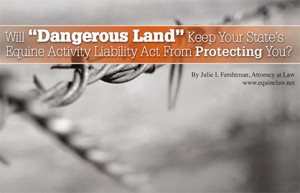Dangerous Land
Click here to read the complete article
Will “Dangerous Land” Keep Your State’s Equine Activity Liability Act From Protecting You?
By Julie I. Fershtman, Attorney at Law
 Nationwide, 46 states (all but California, Maryland, Nevada, and New York) have some form of an Equine Activity Liability Act (as of March 2015). All of these laws differ, but many share common characteristics. Several of them include an exception for a “dangerous latent condition of the land.” Michigan’s law, for example, states that despite protections in the law, an equine activity sponsor, equine professional, or another person might still be liable for an equine-related injury if the person or business:
Nationwide, 46 states (all but California, Maryland, Nevada, and New York) have some form of an Equine Activity Liability Act (as of March 2015). All of these laws differ, but many share common characteristics. Several of them include an exception for a “dangerous latent condition of the land.” Michigan’s law, for example, states that despite protections in the law, an equine activity sponsor, equine professional, or another person might still be liable for an equine-related injury if the person or business:
• Owns, leases, rents, has authorized use of, or otherwise is in lawful possession and control of land or facilities on which the participant sustained injury because of a dangerous latent condition of the land or facilities that is known to the equine activity sponsor, equine professional, or other person and for which warning signs are not conspicuously posted.
A condition is “latent” when its presence is not apparent or visible.
When people have been hurt while riding or near horses, what conditions of land or stable facilities do they claim to be “dangerous latent conditions”? Let’s take a look at some of the cases.
Conditions of Facilities
In these cases, people were hurt on the premises of a stable, and their lawsuits claimed that the stable should not benefit from the equine activity liability law’s immunities because the stable had a “dangerous latent condition” that caused the injury.
• Broken hitching rail. A Georgia case involved a summer camp’s stable facility. A portion of a hitching rail separated from its post and fell over on the plaintiff, a camper, causing injuries. The lawsuit, among other things, blamed the hitching rail for causing the camper’s injuries and argued that the camp should not benefit from Georgia’s Equine Activity Liability Act because the rail was a “dangerous latent condition of the land” about which the camp knew or should have known. The court disagreed and it found that the broken hitching rail did not qualify.
• Broken stall door. In a Kentucky case, an equine veterinarian was sedating a horse in its stall when the horse reared and collapsed onto the stall door. The door then fell over on the veterinarian, causing him to be injured. He sued the stable, claiming that its stall door was a “dangerous latent condition of the land” under Kentucky’s Farm Animal Activity Liability Act. Although the trial court dismissed the veterinarian’s claims, the appellate court refused to dismiss his case and found that a jury should evaluate it.
• Broken fence rail. In an Ohio case, the plaintiff was watching a horse being led toward a pasture gate when the horse suddenly bolted backwards into the gate and caused fence rail boards to pop out of a bracket and strike the plaintiff in the face. Her lawsuit against the land owner claimed that the pasture fence rails qualified as “dangerous latent conditions of the land” under Ohio’s equine activity liability statute. Rejecting that argument, the court found insufficient evidence that the landowner could have known that the fence rails had hidden dangers.
A Horse as a “Dangerous Latent Condition”?
Can a horse qualify as a “dangerous latent condition of the land” under a state equine activity liability law? No, according to one court. In a Georgia case, the plaintiff was riding in a fox hunt when a fellow fox hunter’s horse kicked her. Among the arguments in her lawsuit, she claimed that the fellow fox hunting horse was a “dangerous latent condition” of land. That claim did not succeed.
Conclusion
In conclusion, please keep these ideas in mind:
• 1. Read carefully all statutes applicable to where you live or do business. All equine activity liability acts differ.
• 2. If you believe you have a condition of the land that might qualify as a “dangerous latent condition” – such as a slick, icy patch well-known to exist in your indoor arena but covered with soil – your state equine activity liability act probably requires you to post a “conspicuous warning sign” to alert people to the hazard, not a generalized Equine Activity Liability Act “warning” sign.
• 3. Remember that no equine activity liability law is a complete “zero liability law.” Some claims can succeed. Liability releases (where allowed by law) are important as is proper liability insurance.
This article does not constitute legal advice. When questions arise based on specific situations, direct them to a knowledgeable insurance agent or attorney.
About the Author
Julie Fershtman is one of the nation’s most experienced Equine Law practitioners. A Shareholder with the firm Foster Swift Collins & Smith, PC, based in Michigan, she has successfully tried equine cases before juries in 4 states. She has also drafted hundreds of equine industry contracts. She is a Fellow and officer of the American College of Equine Attorneys. Her speaking engagements on Equine Law span 29 states, and she is the author of 3 books on equine law issues. For more information, please visit www.fershtmanlaw.com, www.equinelawblog.com, and www.equinelaw.net.










